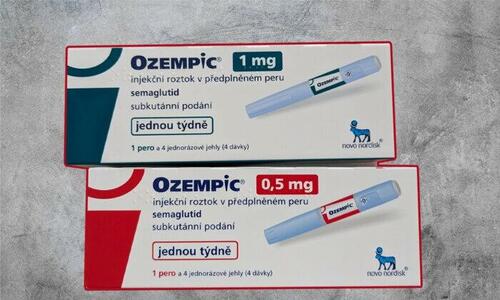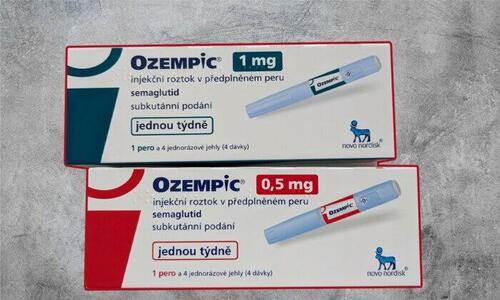
1 In 8 US Adults Have Tried GLP-1 Obesity Medications, Poll Finds
Authored by Amie Dahnke via The Epoch Times (emphasis ours)
One in eight American adults have used popular weight loss and diabetes drugs known as GLP-1 agonists, according to the latest KFF Health Tracking Poll.
 (Photos from Shutterstock / Designed by The Epoch Times)
(Photos from Shutterstock / Designed by The Epoch Times)The survey, which involved nearly 1,500 adult participants and was carried out in late April, found that two-thirds of those currently using the drugs are doing so to manage diabetes or heart disease, while roughly four out of 10 are taking the medication primarily for weight loss.
Approximately 6 percent of U.S. adults, equating to over 15 million people, are currently taking a prescribed medication from the GLP-1 agonist class of drugs, according to the poll.
Other Key Findings
Other key findings reveal that, among those who have ever taken GLP-1 agonists, 43 percent were diagnosed with diabetes by a doctor, 25 percent were diagnosed with heart disease, and 22 percent were told by a doctor within the last five years that they were overweight or obese.
The reasons for using these drugs are nearly evenly split: 39 percent of Americans turn to GLP-1 agonists to treat a chronic condition, while 38 percent use them for weight loss. The remaining 23 percent rely on the drugs to address both chronic conditions and weight management.
The poll also confirms media reports that the popularity of these drugs has surged over the past couple of years. According to the survey, 32 percent of adults now say they have heard “a lot” about GLP-1 agonists, an increase of 19 percent from July 2023.
Despite their growing popularity, the poll noted that 54 percent of all adults who have taken GLP-1 drugs find it difficult to afford the cost. One in five adults who took the drugs said it was “very difficult” to afford them. While insurance sometimes covers part of the cost, even insured adults found the expenses challenging, with 53 percent reporting difficulties in bearing the costs.
Ozempic, produced by Novo Nordisk, is listed at $935.77 for a monthly injection, while Wegovy is priced at $1,349.02 for a 28-day supply—both without health insurance.
One in five adults aged 50-64 report having taken GLP-1 drugs at some point, a higher proportion compared to other age groups. Among this 50-64 age bracket, 15 percent indicate using these medications to treat chronic conditions, while 5 percent took them solely for weight loss purposes. Relatively few adults under 50 have taken GLP-1 drugs for managing chronic illnesses, but similar shares of 18-29 year olds (7 percent) and 30-49 year olds (6 percent) reveal using them for weight loss goals.
Most Americans Want Medicare Coverage
While some insurance providers offer coverage for GLP-1 agonist drugs, Medicare does not cover these medications if they are prescribed for weight loss purposes. The poll reveals that only 8 percent of adults aged 65 and older took a GLP-1 drug for a chronic condition, and 1 percent used it solely for weight loss. This is despite 37 percent of poll respondents aged 65 and above reporting that a doctor had informed them they were overweight or obese.
Most poll respondents believe that Medicare should begin covering prescription drugs for weight loss (though the program is currently prohibited by law from doing so). In fact, 60 percent of adults who responded to the poll support Medicare providing coverage for such prescription medications.
Several GLP-1 agonists are available on the U.S. market for people with diabetes or who are obese, including Ozempic, Trulicity, Byetta, Victoza, Rybelsus, Adlyxin, and Bydureon. A similar class of medication called a GLP-1/GIP receptor agonist, such as Mounjaro, is also prescribed. Wegovy is a relatively newer GLP-1 agonist marketed specifically for those seeking to manage their weight.
GLP-1 agonists work by mimicking the GLP-1 hormone naturally produced by the body. This hormone is secreted from the small intestine and is responsible for triggering insulin release, blocking glucagon secretion, and slowing stomach emptying. It also helps create a feeling of fullness after eating by affecting areas of the brain that process hunger and satiety signals.
Tyler Durden
Tue, 05/14/2024 – 18:20















